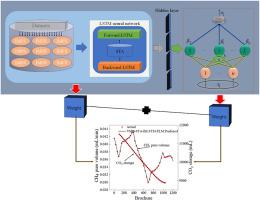Predictive combination model for CH4 separation and CO2 sequestration with CO2 injection into coal seams: VMD-STA-BiLSTM-ELM hybrid neural network modeling
IF 9
1区 工程技术
Q1 ENERGY & FUELS
引用次数: 0
Abstract
In the experimental process of separating coal seam gas using the CO2 displacement method, establishing a predictive model for key variables is essential to optimize displacement parameters, increase coal seam gas recovery, and improve CO2 sequestration efficiency. Traditional modeling methods often struggle with the complex nature of industrial data and are susceptible to overfitting due to multicollinearity caused by long-term datasets. This paper presents a hybrid predictive model based on variational mode decomposition (VMD), a spatiotemporal attention mechanism (STA), a bidirectional long short-term memory network (BiLSTM), and an extreme learning machine (ELM). During the offline phase, VMD is used to decompose raw data into intrinsic mode functions (IMFs). The hidden state from the last time step of the STA-BiLSTM is then added to the original data to enrich the features for ELM training. In the online prediction phase, the outputs from the VMD-STA-BiLSTM and VMD-STA-BiLSTM-ELM models are combined using an error reciprocal method to generate the final prediction. The proposed model is validated with experimental datasets from CO2 displacement for coal seam CH4 under various conditions, as well as with N2-ECBM and CO2-ECBM engineering datasets. The results show that the hybrid model surpasses VMD-ELM, STA-BiLSTM-ELM, BiLSTM, STA-BiLSTM, ELM, TCN, and Attention-TCN models in predictive accuracy. Even in multi-step and rolling predictions, the model exhibits minimal impact from cumulative errors, maintaining accurate forecasts with strong generalization and robustness. It effectively captures feature patterns across different datasets and accurately predicts unknown data. The model shows potential for application in diverse scenarios and complex environments, offering reliable support and decision-making for the field application of CO2 displacement in coal seam CH4 separation. It is an effective and promising predictive approach to enhance coal seam gas recovery and CO2 sequestration efficiency.

将二氧化碳注入煤层进行甲烷分离和二氧化碳封存的预测组合模型:VMD-STA-BiLSTM-ELM 混合神经网络建模
在利用二氧化碳置换法分离煤层气的实验过程中,建立关键变量的预测模型对于优化置换参数、提高煤层气采收率和二氧化碳封存效率至关重要。传统的建模方法往往难以应对工业数据的复杂性,并且容易因长期数据集造成的多重共线性而导致过拟合。本文提出了一种基于变模分解(VMD)、时空注意力机制(STA)、双向长短期记忆网络(BiLSTM)和极端学习机(ELM)的混合预测模型。在离线阶段,VMD 用于将原始数据分解为内在模式函数(IMF)。然后,将 STA-BiLSTM 最后一个时间步的隐藏状态添加到原始数据中,以丰富 ELM 训练的特征。在在线预测阶段,使用误差倒数法将 VMD-STA-BiLSTM 和 VMD-STA-BiLSTM-ELM 模型的输出结合起来,生成最终预测结果。利用各种条件下煤层 CH4 的二氧化碳置换实验数据集以及 N2-ECBM 和 CO2-ECBM 工程数据集对所提出的模型进行了验证。结果表明,混合模型的预测精度超过了 VMD-ELM、STA-BiLSTM-ELM、BiLSTM、STA-BiLSTM、ELM、TCN 和 Attention-TCN 模型。即使在多步预测和滚动预测中,该模型也能将累积误差的影响降至最低,从而保持准确的预测结果,并具有很强的泛化能力和鲁棒性。它能有效捕捉不同数据集的特征模式,并准确预测未知数据。该模型显示了在不同场景和复杂环境中的应用潜力,为煤层甲烷分离中二氧化碳置换的现场应用提供了可靠的支持和决策。它是提高煤层气采收率和二氧化碳封存效率的一种有效且有前景的预测方法。
本文章由计算机程序翻译,如有差异,请以英文原文为准。
求助全文
约1分钟内获得全文
求助全文
来源期刊

Energy
工程技术-能源与燃料
CiteScore
15.30
自引率
14.40%
发文量
0
审稿时长
14.2 weeks
期刊介绍:
Energy is a multidisciplinary, international journal that publishes research and analysis in the field of energy engineering. Our aim is to become a leading peer-reviewed platform and a trusted source of information for energy-related topics.
The journal covers a range of areas including mechanical engineering, thermal sciences, and energy analysis. We are particularly interested in research on energy modelling, prediction, integrated energy systems, planning, and management.
Additionally, we welcome papers on energy conservation, efficiency, biomass and bioenergy, renewable energy, electricity supply and demand, energy storage, buildings, and economic and policy issues. These topics should align with our broader multidisciplinary focus.
 求助内容:
求助内容: 应助结果提醒方式:
应助结果提醒方式:


